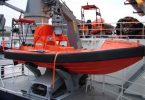Shippers and clearing agents could face heavy penalties if they do not comply with the new maritime shipping regulations, Kenya Ports and maritime authorities have said.
New Safety of Life At Sea (SOLAS) rule came into force from July 1, that requires shippers to present verified gross mass (VGM) certificates before their containers are loaded on vessels. SOLAS regulations makes it mandatory for shippers to verify the gross weight of every export cargo prior to loading, Jocye Awino from the Kenya Maritime Authority (KMA), said.
The amended law was adopted by the International Maritime Organisation last year.
According to Awino, one out of every five containers, is under-declared, endangering people’s lives, as well as cargo and maritime trade across the region. Awino was speaking during a sensitisation workshop on the new SOLAS, customs and shipping declarations and process organised by KPA in Kigali on Tuesday.
The new guidelines, according to Jaka Alfred, a senior operations officer at KMA, are designed to improve maritime safety and trade across the region.
“It is also trying to address the increasing cases of under declaration of container weights that has often resulted into casualties to vessels, crew members and stevedores, and damage to vessels lifting equipment” Jaka said.
The requirements will be enforced by KMA at the port of Mombasa, with authorities conducting simultaneous inspection of up to 25 containers before they are loaded onto a ship, Jaka said.
Andrew Opiyo, KPA’s senior documentation officer, said Marine Notice number 18, SOLAS places the responsibility of providing verified gross mass of a container on shippers.
“It is essential that information is provided timely to the relevant parties because this helps ensure continuous flow of cargo,” he said. “This will avoid potential delays and congestion in the port as the VGM should be used in preparation of a vessels loading plan.”
Shippers speak out Though shippers welcomed the new regulation, they are worried the requirement could become another non-tariff barrier if it is not implemented properly and cautiously.
Theodore Murenzi, the vice-chairperson of the Rwanda Shippers’ Council, said the new regulations need to be harmonised with the weigh bridge system to avoid any unnecessary delays of cargo.
How the new regulation works SOLAS prescribes two methods through which shippers can obtain verified gross mass of a packed container, after weighing a packed and sealed container. However, weighing the cargo, including packaging and dunnage (securing) materials and the tare weight of the container, will be approved and certified.
It is essential that containers are weighed accurately using equipment accredited by the National Regulator for Compulsory Specifications and national standards bodies, experts say.
Any discrepancy between a packed container’s gross mass and its verified gross mass should be resolved by use of the VGM. A container that exceeds its maximum permitted gross mass is not loaded onto a vessel. The same applies in circumstances, where a container is delivered to a port terminal without the shipper providing the VGM of the container. Ultimately, only cargo that is deemed safe and meeting guidelines should be loaded for onward transportation.
Alternatively, shippers can weigh all packages and cargo items, including the mass of pallets, dunnage and other securing material to be packed in the container and add the tare mass of the container to the sum of the single masses.
Shippers are expected to list all types of equipment used in weighing the packed container or cargo items, packaging materials, pallets, dunnage, including scales, weighbridge, lifting weighing equipment. Only a single container on vehicle shall be weighed at any one given time, according to the new guidelines.








found it VERY informative ….